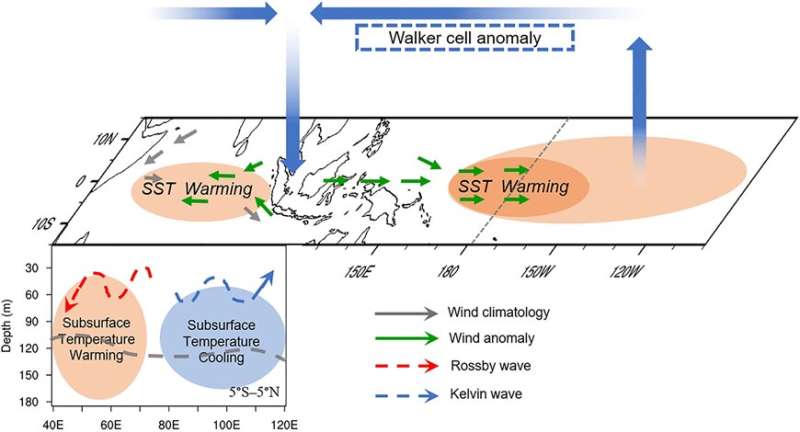Study unveils intrinsic upper-ocean temperature variability in tropical Indian Ocean

The Indian Ocean dipole (IOD) is an irregular oscillation of sea surface temperatures in which the western Indian Ocean becomes alternately warmer and then colder than the eastern part of the ocean.
IOD has been widely studied as the dominant mode of sea surface temperature anomalies over the tropical Indian Ocean (TIO) because it plays an active role in regional and global climate on the seasonal and interannual timescales. The air-sea coupling processes associated with IOD are modulated by the upper-ocean thermal structure.
Recently, researchers from China and the U.S. conducted a series of studies concerning the subsurface variability and further identified an inherent oscillation with a quasi-regular period around 15 months in the TIO subsurface temperature, which forms the baseline of the IOD variability.
The researchers conducted deep analysis of the peak phases in this equatorial oscillation that is characterized by a subsurface east-west dipole pattern called subsurface Indian Ocean dipole (sub-IOD). Most sub-IOD events co-occur with a surface IOD in autumn. However, some sub-IOD events still can develop in winter-to-spring independently from the surface IOD. These sub-IOD events are closely connected to the western-type Central Pacific El Nino–Southern Oscillation (ENSO).
"These results may advance our understanding of the interactions between the surface and subsurface, as well as the remote influences from different ENSO events on their occurrence, and improve future projections of the IOD and its effects on the Earth's climate," said Song Ge from the Institute of Atmospheric Physics of the Chinese Academy of Sciences, lead author of the study.
Related results were published in Journal of Climate and Geophysical Research Letters.
More information: Ge Song et al, Basin-Wide Connections of Upper-Ocean Temperature Variability in the Equatorial Indian Ocean, Journal of Climate (2021). DOI: 10.1175/JCLI-D-20-0419.1
G. Song et al, Linking the Subsurface Indian Ocean Dipole to Central Pacific ENSO, Geophysical Research Letters (2022). DOI: 10.1029/2021GL096263
Journal information: Geophysical Research Letters , Journal of Climate
Provided by Chinese Academy of Sciences





















